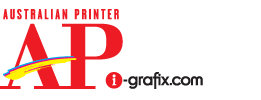Finishing for digital print is one of the major themes at Ipex, with solutions vendors large and small setting out their stalls to supply kit that will transform flat print into added value product, writes Wayne Robinson from London.
Morgana, which is now owned by Plockmatic and sold through dealers in Australia had what managing director Andy Cooper described as ‘third generation’ finishing equipment on the stand. This included a new crease and fold system that can handle the 900mm 6up A4 prints coming off some of the newer digital printers. It has touchscreen control and runs at a decent 6000 sheets an hour.
It also launched its deep pile autocreaser and folder, the Pro500, for higher volume runs, it will arrive in Australia early next year.
Morgana also launched a new PUR binder, the 200 series, which is the same as the 150, but fully automated, whereas the 150 was manual feed. It handles landscape A4 blocks, and has an autoclean nozzle system. Cooper says, “It is entry level, and does a great job.”
Also launching a new PUR 200 cycles an hour perfect binder was Duplo – which is sold in Australia through Neopost GBC – with its Ultra 200. Philip Greenhaugh, managing director of Duplo UK says, “For short run digital printers the new entry level Ultra 200 is a great solution. Not only does it enable cost effective inhouse perfect binding but it has a fully closed PUR tank, meaning it is operator and environmentally friendly.”
Duplo also launched the new 646 multi-finish system. It creases, slits, perfs, folds, in fact performs about eight different finishing actions all in the one pass.
Greenhaugh says, “The new Duplo 646 gives digital printers virtually every finishing solution they could want, but all in one machine.” A barcode printed on the sheet provides the instructions for the 646, which can among other things make boxes.
Israeli technology developer Scodix also had a new Ultra on display, although this was a superfast version of its S75 Pro, the B2+ sized Ultra working at 1250 sheets an hour as opposed to the 650 on the S75 Pro. Marcus Adler, marketing manager at Scodix says, “The Ultra will appeal to both offset and digital printers because of its speed, reliability and sheer breadth of product.”
The new Ultra enables foiling, metallising, glittering, embossing, braille, spot UV and a host of other embellishments. Because it is driven by digital technology every sheet can be different, for instance wedding invitations could have everyone’s name embossed. The registration reliability at the new higher speeds comes through a four camera system allied with overlapping delivery plates rather than a belt transport.
FAB Equipment will be bringing the latest Watkiss solutions to Australia. Owner Matthew Benn says, “The PowerSquare system means lie-flat square bound stitched books. Until now it has been used mainly for school textbooks, but the latest version will appeal to the short run magazine market.” The system can be configured to run inline or near line. Benn says, “For instance a digital printer with multiple print engines can run it offline, and one system could keep up with the output from several print engines.”
Watkiss also launched the entry level Bookmaster Pro Document Finishing System, which according to Benn runs 25 per cent faster than the previous system at 30 sheets. He says, “The new Bookmaster Pro is aimed at digital printers looking to exploit opportunities for a low entry cost.”
As well as Watkiss FAB supplies finishing from developers such as James Burn and KAS, which had its new heavy duty mailing system on the stand. Benn says, “It sits between the office type products and the high end mailing systems, so there is going to be a big market for it as there is nothing there at the moment.”
Horizon – which is supplied in Australia by Currie Group – had its Stitchliner 6000 system working throughout the show producing the Ipex Daily magazine. It was located on the Fujifilm stand, where the JetPress 540W was printing 5,000 copies of the Daily each evening. From there the reel went to a Lasermax unwind and sheeter, which then fed the Horizon 6000, which collated, folded, trimmed and stitched the product. The 6000 is an L shape system, against the U shape of the 5500, as it allows a higher running speed.
GO TO MORE AUSTRALIA NEWS Print | i-grafix.com | Print News | Packaging News | Wide Format news | Australia, New Zealand and Asia Print and Packaging news from Australia, New Zealand and Asia
Print | i-grafix.com | Print News | Packaging News | Wide Format news | Australia, New Zealand and Asia Print and Packaging news from Australia, New Zealand and Asia







